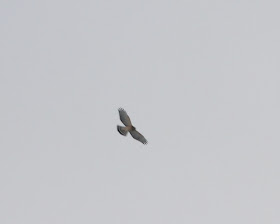This past weekend
Ken and I had an excuse to head on a road trip to Ithaca, NY. Our excuse was that Ken was purchasing a microphone from
Old Bird for use during his Master's research (plus I wanted one to put up on my roof and record nocturnal migrants!). It also just so happens that my friend,
Mothboy, just started a new job at Cornell!
So we headed down on Friday and arrived about dinner time at Mothboy's place. On the drive we ran into a few flocks of Greater Snow Geese, right near the town of Waterloo. One flock was right beside the road:
 |
| Snow Geese near Waterloo, NY. March 2, 2012 |
 |
| Snow Geese near Waterloo, NY. March 2, 2012 |
There was even one neck-banded bird, which I have submitted to the
bird banding lab and currently waiting to hear back where it was originally tagged:
 |
| "RX63" near Waterloo, NY. March 2, 2012 |
Snow Geese are really neat birds for a lot of reasons, but perhaps most interesting are the two colour morphs, "Blue" and "White". There is lots of great information about Snow Geese on the
Birds of North America online website, which I've taken a few highlights from here. Up until 1983, Blue Goose was considered a separate species from Snow Goose. Based on some genetic work, Blue Goose and Snow Goose were likely reproductively isoloated until about 70 years ago. The ratio of "Blue" Geese in a population is quite low in far western North America and far eastern North America, while the mid-continent populations have fairly high proportions. There are two recognized subpecies of Snow Goose (Greater,
C. c. atlantica and Lesser,
C. c. caerulescens). Overall the Lesser subspecies is more abundant and widespread, while the Greater subspecies has a smaller range.
This is all great information to have when watching for Snow Geese in Ontario. Ontario happens to be right between two Snow Goose flyways. Southwestern Ontario gets Lesser Snow Geese on their way north from wintering grounds in the south central US - these flocks usually contain a high percentage of "Blue" Geese. Usually most Lesser Snow Geese show up west of Toronto, and you are more likely to encounter them the further south and west you go. Then as you travel east through Southern Ontario you go from about Toronto to Kingston where any Snow Goose is fairly uncommon. East of Kingston though you get closer to the core migration route of Greater Snow Geese. If you're lucky to find some, they will be almost all white morph birds. The Greater Snow Geese have really increased in numbers (as have most populations of Lesser Snow Geese) in the last couple decades to the point where hunting seasons have been implemented or expanded, since the increased population can do serious damage to wintering and breeding habitats. As the population has increased we started seeing these birds begin to use easternmost Ontario along the St. Lawrence River as a staging area- it's definitely something work checking out if you get the chance. Here's a photo I took last spring near Cornwall of part of a flock of about 20,00 birds:
 |
| Big Snow Goose flock near Lancaster, ON. March 23, 2011 |
Anyways, I never realized how far west in New York state Greater Snow Geese came before heading north east towards the St. Lawrence River.
We got to spend Saturday exploring and doing some birding around the finger lakes, which is a really nice area. There are really big hills, fast moving streams, and quite extensive deciduous forests all over the place (really puts into perspective how good of a job we did at clearing the forests of Southern Ontario). Here's a picture I snapped with my phone of the shoreline of Seneca Lake:
 |
| Seneca Lake, NY |
It was great to experience what southern Ontario could look like if there was more forest cover. Red-bellied Woodpecker, Tufted Titmouse, and Carolina Wren were all common (we had all of them at Mothboy's house). On Saturday we made a quick stop at the Cornell Lab of Ornithology, which was pretty neat to see.
 |
| Mothboy and Ken at Sapsucker Woods |
We walked a short trail there (didn't see too much) and tried to identify some trees (think we got Cherry Birch). Skunk Cabbage was out:
 |
| Skunk Cabbage! |
All in all it was a really fun weekend, can't wait to go back, and can't wait to get my microphone set up and see what's flying over my house!
--------------------------------
I bet you thought I was going to make it through a whole blog post without mentioning eBird, right? Well wrong. Of course, we submitted lots of checklists during the trip and I now can say I have 64 species on my New York State eBird list (up from the two got while sitting in a plane on the runway in New York City.
I guess I should also mention that I did an interview yesterday for a show that aired today on CBC radio's The Current. The story was about bird migration, climate change, and eBird. They interviewed one of the authors of
this paper. Here's the link if you're interested in checking out the
whole radio show.


























